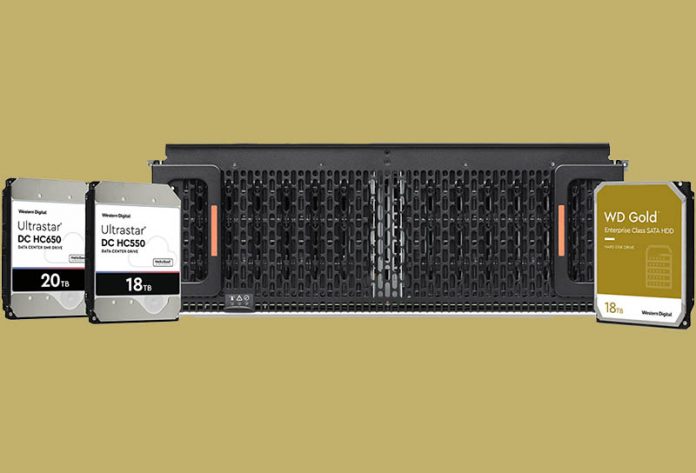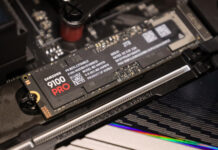Today we have a number of new announcements from Western Digital. First, the company is shipping energy-assisted magnetic recording (EAMR) technology hard drives. Second, WD Gold 16TB and 18TB drives are now shipping. The company has a new host-managed SMR 20TB Ultrastar DC HC650 in qualification. Finally, the company is updating its JBODS with the 16TB and 18TB drives.
WD Energy-Assisted Magnetic Recording (EAMR)
WD has been working on EAMR for a decade or more at this point. To increase the areal storage density of a platter, the recording layer has ever smaller magnetic areas or grains. At some point, these small areas get so small that they become thermally unstable and cannot maintain their magnetization.
With EAMR additional current is placed on the write head’s main pole, thereby creating a more precise and stronger magnetic fields for writes. By using this process, WD can shrink the writable magnetic areas by utilizing materials that otherwise would not be suitable. [Edit: corrected original]
WD Ultrastar DC HC550 16TB and 18TB drives are the first shipping drives using EAMR and the DC HC650 20TB drive that is shipping for qualification is using EAMR as well.
WD Gold 16TB and 18TB Drives
Along with the Ultrastar DC HC550 16TB and 18TB drives that are now shipping to more customers, the new WD Gold 16TB and 18TB drives are now shipping. These are being shipped into the channel so that companies building higher-end storage can utilize the new drives.
We are finally seeing these larger capacity drives hit more market segments. Let us be clear, WD is doing a great job calling out the CMR 16TB and 18TB drives here along with the SMR 20TB drive. It has been common practice in the industry to disclose this information at the higher-end. Now, the company is starting to do so even in its other lines. This is something STH advocates strongly.
These drives are somewhat in an interesting position. This is the portion of the market where SSDs are already meeting or exceeding capacities which makes these a $/TB value play even though they are premium data center drives. STH will have a piece on 15-16TB SSDs just after this is published.
WD Ultrastar 20TB Host-Managed SMR Drives
These are drives that are not yet in GA status, but the company says it hopes to have the WD Ultrastar DC HC650 20TB host-managed SMR drives available in its storage servers and JBODs “next quarter” which would be (calendar) Q4 2020. Those platforms are the Ultrastar Data60 and Data102 JBODs and the Serv60+8 for our readers who want to look them up.
Hitting 20TB is a big deal. Something that is interesting here is that a WD Ultrastar HC650 20TB is now only about 11% higher capacity than the 18TB Ultrastar HC550 18TB drive. For years we have been hearing that one can get 25% more capacity using SMR. If that holds true with EAMR hard drives, then we may be looking at a 22TB WD host-managed SMR drive in the not-too-distant future.
Again, in this segment, using host-managed SMR makes a lot of sense and we want to be clear that it is completely appropriate and different than using DM-SMR in the WD Red line.
Final Words
Hard drive capacities are moving upward again. Later today we are going to feature an EDSFF 1U platform with about half a petabyte of NVMe storage. Given that is available today, one must remember that we are rapidly approaching the point where these large hard drives are effectively a value play with the density and performance crowns going to SSDs, especially newer form factors.
There has been a lot out there about using SMR in hard drives recently, and quite a bit by STH. Let us be clear, SMR is not a bad technology when disclosed and used in proper scenarios. As hard drives are relegated to low $/TB storage scenarios SMR is going to be a technology we will see more of. It is great that WD has both CMR and SMR drives using their new EAMR recording technology.





Crazy how just a few months ago a new product announcement from WD would have been met with enthusiastic or at least favorable interest but now it feels like it has to be read carefully, looking for signs of deception.
Not to mention this used to be called HAMR, Heat Assisted Magnetic Recording… now they’re changing the name to EAMR? WD’s gonna lose trust fast
@Evan Richardson
No they announced this a long time ago. EAMR = both HAMR and their own MAMR ( Microwave Assisted ). Thy Lump both of these together as EAMR technology.
AFAIK EAMR is a different thing enterily from both HAMR and MAMR.
It seems to be a stepping stone on the way to the still too expensive/difficult mass implementation of HAMR+MAMR.
Toshiba seems to go down this route too.
Only Seagate seems to not need this stepping stone and will soon offer HAMR (or MAMR? i am not sure ATM) directly.
While i have waited long HDD capacities to grow: It is hard to celebrate when NAS drives still cost nearly or exactly as much as 4 years ago (e.g. the 8TB Ironwolfs i mainly use).
Ever since the 2011 tsunami, HDD prices are just insane. Which brings me to believe that SSDs will win the price/TB race sooner than expected. Even more so now that China is pushing hard into the flash market.
newsletter
CONFIRMATION:
Like i thought, WD is using a different time of EAMR, not HAMR or MAMR.
They call it ePMR:
https://documents.westerndigital.com/content/dam/doc-library/en_us/assets/public/western-digital/collateral/tech-brief/technical-brief-continuous-innovation.pdf
Is SMR even worth it now ?
All that crap for what – 10% of capacity ?
In other words, HAMR/MAMR is still “too hard” to reliably deploy (or too large to fit between platters)
I hold the same feeling about HDD pricing since 2011. Even in the great capacity pause around 2001-2004 the price per GB kept falling. As with ram pricing in the 1990s after the Sumitomo fire, cartel behaviour has taken over and pricing has become “What the market will bear”
It’s going to be “interesting” to see what happens to HDD pricing when large SSDs start encroaching into their price range. QLC from Micron and Samsung is already in the 2x Enterprise HDD range (3x consumer NAS drives) and it’s only going to keep coming down.
With the traditional “jumping off” point from HDD to SSD for buyers being 4x the price of HDDs (the advantages of SSD kill the price penalty at that point) the makers have been staving things off at the low end because of consumer price sensitivity but it’s a different ball of wax in Enterprise.
At some point we really need to start seeing multiple actuators show up in drives, before rebuilds end up in the week(s) range. 20TB is nuts